Survey of Some of the Best English-Language Haggadot: Short Reviews and Snippets
The English-reading public has been blessed with an extraordinary array of Haggadot. We have come a long way from our forefathers’ story of the Exodus, which was largely based on the Maxwell House Haggadah (which, of course, is still available, for the traditionalists among us). Here are some brief reviews and excerpts from some recently published, widely available Haggadot, in no particular order:
Studies on the Haggadah: From the Teachings of Nechama Leibowitz
Edited by Yitshak Reiner and Shmuel Peerless
Urim Publications
Jerusalem, 2002
159 pages
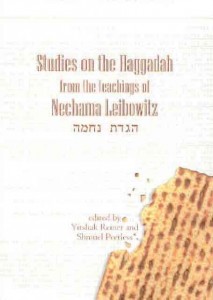 This Haggadah will appeal to the greatest extent to the many students Nechama Leibowitz acquired through her gilyonot (study sheets) on the Torah. The work is very didactic, and pertains mostly to the sections of the Haggadah that are based on pesukim in the Torah—reflecting the material’s source in Nechama’s shiurim and writings on that material. Interesting personal vignettes from Nechama’s life are scattered throughout the Haggadah as well.
This Haggadah will appeal to the greatest extent to the many students Nechama Leibowitz acquired through her gilyonot (study sheets) on the Torah. The work is very didactic, and pertains mostly to the sections of the Haggadah that are based on pesukim in the Torah—reflecting the material’s source in Nechama’s shiurim and writings on that material. Interesting personal vignettes from Nechama’s life are scattered throughout the Haggadah as well.
Nechama liked to refer to the Four Questions to demonstrate the difference between a kushyah and a she’eilah. The Four Questions, she pointed out, are referred to as the Arba Kushyot rather than the Arba She’eilot. This is based on the way in which the questions are framed. Each of the questions follows the same format: On all other nights we ___, but tonight we ___. According to Nechama, this format represents a kushyah, as opposed to the simple she’eilah format which would be: Why on this night do we ___? The she’eilah is a simple informational question. The kushyah, on the other hand, takes note of something that deviated from the norm. The kushyah is the fundamental pedagogic instrument of both the Pesach Seder and of Biblical exegesis. Nechama’s insight turns what many think of as the child’s part of the Seder ritual into a sophisticated paradigm for Torah learning.
The Chazon Ish Haggadah
By Rabbi Asher Bergman
Adapted into English by Rabbi David Oratz and E. van Handel
Mesorah Publications
Brooklyn, 2006
304 pages
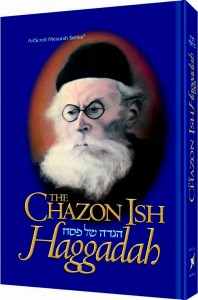 Among the Haggadot in this review, this is the only one that I find necessary to caution readers against. The Haggadah is replete with strange anecdotes of dubious credibility, sprinkled with a liberal amount of gratuitous swipes at the State of Israel and its leaders. The following excerpt is among the more innocuous!
Among the Haggadot in this review, this is the only one that I find necessary to caution readers against. The Haggadah is replete with strange anecdotes of dubious credibility, sprinkled with a liberal amount of gratuitous swipes at the State of Israel and its leaders. The following excerpt is among the more innocuous!
“We cried out to Hashem, the God of our fathers.”
Prayer has always been the Jewish people’s weapon.
Once, when the Holocaust was discussed, the Chazon Ish told his brother-in-law, R’ Shmuel Greineman, “Heaven hid the matter from me. Had I known, I would have stopped it. When the Germans were poised to enter the Land of Israel, I knew and I stopped it.”
In 5708 (1948), the Arab Legion shelled Jerusalem day and night, killing many Jews, The Chazon Ish told his sister, Rebbetzin Tzivia Greineman, “The Brisker Rav requested that we do something about the shelling. More than that I am forbidden to reveal.”
Light of Redemption: A Passover Haggadah Based on the Writings of Rav Kook
By Gideon Weitzman
Urim Publications
Jerusalem, 2005
159 pages
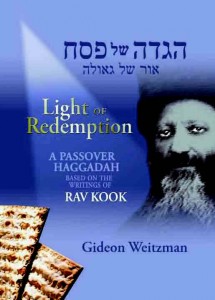 Rabbi Gideon Weitzman writes: “The commentary here is based on the writings and thoughts of Rav Kook, particularly those that appear in the second volume. However, other sources have been used as well. All translations are my own, and, while all the ideas are based on Rav Kook, they are not necessarily direct translations.”
Rabbi Gideon Weitzman writes: “The commentary here is based on the writings and thoughts of Rav Kook, particularly those that appear in the second volume. However, other sources have been used as well. All translations are my own, and, while all the ideas are based on Rav Kook, they are not necessarily direct translations.”
The Simple Son
In the Torah this son appears before the wise son. The verse “What is this?” is taken from the book of Shemot (13:14) and the question of the wise son appears only later, in the book of Devarim (6:20).
The message here is that one needs to be simple before he can be wise. The initial stage of learning is to understand the basic concepts and to ask simple questions. The simple son wants to know what to do and he receives a clear answer. The wise son looks deeper for meaning, rhyme, and reason. This knowledge is important but it cannot be attempted before one has grasped the basic understanding of what to do.
“Therefore we are obliged to give thanks.”
This starts the first half of the Hallel that we recite at the Seder. A question is asked as to why we do not recite the blessing over the Hallel during the Seder. After all, when we say Hallel as part of our prayers, we do make the blessing.
We could answer that on all other occasions that we recite the Hallel, we do so as part of our religious obligation. When we remember that God commanded us to observe the festivals due to past events, we recite the Hallel. As it is a religious requirement, we recite the blessing.
However, at the Seder we do not recite the Hallel only as a religious requirement. Rather, if we see ourselves as coming out from Egypt we feel a deep appreciation to God. The Hallel is a natural reaction and a way to show our thanks and praise of God. The Hallel is an essential response to having relived the story of the Exodus. Therefore we do not recite the berachah before saying the Hallel; we simply turn to God to praise Him.
The Pesach Haggadah: Through the Prism of Experience and History
By Rabbi Berel Wein
Shaar Press
New York, 2004
223 pages
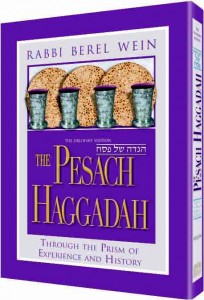 This Haggadah is, as the title of a book of Rabbi Berel Wein puts it best, “Vintage Wein.” The commentary is wonderful, but the Haggadah (which is written in first person, an innovation that I have previously seen) is outstanding when the comments are personal.
This Haggadah is, as the title of a book of Rabbi Berel Wein puts it best, “Vintage Wein.” The commentary is wonderful, but the Haggadah (which is written in first person, an innovation that I have previously seen) is outstanding when the comments are personal.
I have always enjoyed looking at Haggados from different periods of Jewish history. One of the more fascinating things that I have discovered in perusing these Haggados is the illustrations that are used to represent the evil son. He is always portrayed as wearing the most stylish and provocative clothes of that period, be it Roman armor and toga, Renaissance Italy, Dutch feathery, Cossack Eastern Europe, foppish Victorian England or Roaring Twenties America. These depictions of the evil son may well be inaccurate and even unfair, but they reflect the belief that being too radically up to date and “cool” is not really the Jewish way. The wise son always seems to be dressed more conservatively than his evil brother. Apparently, appearances do count in this world of ours, even in our illustrated Haggados. It is true that a person may be wise and pious and yet dress wildly differently from the norm, and a person may dress in rabbinic garb and have “his tzitzis showing on the outside, visible to all, while his heart may be far away from his Father in Heaven,” in the words of R’ Menachem HaMeiri (Sotah 20b). Yet, the way a person looks and dresses often says a great deal about his character, beliefs and behavior. One can also note how the garb of the wise son has changed over the centuries in illustrated Haggados.
Here’s another one:
In life, all of us know that many times it is the small things that count. A great event can be ruined or diminished by a small flaw in planning or execution. I have often seen how the wonder of transcontinental flight in a jumbo jet is erased by a minor discomfort or a surly flight attendant. God, therefore, knowing our human frailties all too well, arranged for a “perfect” Exodus and sojourn in the desert for the Jews. Even this perfection did not prevent the people from complaining, but there is no doubt that it was God’s intent, so to speak, to please us completely.
From Bondage to Freedom: The Passover Haggadah with a commentary illuminating the liberation of the spirit
By Rabbi Abraham J. Twerski, MD, with Rabbi Hirsh Michel Chinn, MSW, and Rabbi Benzion Twerski, PhD
Shaar Press
New York, 1995
239 pages
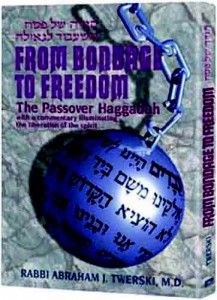 This is my personal favorite among all the Haggadot included in this review. It is chock full of original, brilliant—yet realistic and relevant—psychological and philosophical insights. The treatment of Hebrew names is somewhat curious (Phineas?), but that does not detract from the work’s utility and vitality.
This is my personal favorite among all the Haggadot included in this review. It is chock full of original, brilliant—yet realistic and relevant—psychological and philosophical insights. The treatment of Hebrew names is somewhat curious (Phineas?), but that does not detract from the work’s utility and vitality.
“We cried out to Hashem, the God of our fathers.”
…We say that we cried out onto [sic] God to be merciful and relieve our distress and that he heard our prayers. Yes, but why all the years of suffering? Why did He not intervene earlier?
While this question does not always have an answer that satisfies our logic, I did gain some insight into this in a pediatrician’s office.
A mother had brought her infant to the doctor for immunization. As soon as the child saw the white-clad doctor, he began crying, remembering only too well what had befallen him at this man’s hands just several months earlier.
The mother assisted the physician by forcefully restraining the child, who clawed and kicked her. If we could enter the child’s mind, we would no doubt discover that he was violently angry at his mother who had suddenly betrayed him, and who, instead of protecting him from harm as she always did, was now collaborating with this brutal aggressor who was going to stab him with a sharp instrument.
The moment the physician withdrew the needle and the mother released her restraining hold, the infant embraced her and clung to her for dear life. But why? Was she not the very person who had just betrayed him and had subjected him to such intense pain?
Obviously, the infant’s trust in the mother was so great that even though he thought she had allowed him to be hurt, he nevertheless turned to her for comfort, protection and relief from the pain. This is precisely how we relate to God. Although we cannot understand why He subjects us to suffering any more than the infant can understand his mother’s behavior, our trust in Him is so great that it is not shaken by our own suffering. Even when we angrily protest, we are nevertheless aware that God is a loving and caring Father, and that is why we appeal to Him in our distress….
“A kid, a kid.”
…Even people of great spirituality must exert caution when motivated by zeal. The Torah states that Phineas was handsomely rewarded for avenging the desecration of the Divine honor when he slew an adulterer who publicly profaned the Torah. Years later, in his other identity as Elijah, he fled into the desert because he could not tolerate the Israelites’ idolatrous behavior, but the Midrash states that this time God rebuked him for his zeal. The commentaries ask: Why was he rewarded for his initial zealousness but chastised for its repetition?
The answer, they say, is that a single act of zeal may be assumed to be genuine, and a person who overcomes his natural passivity to avenge injustice is praiseworthy. However, if he commits repetitious acts of zealousness, it must be suspected that his motives are not purely in the interests of righteousness and justice, but are tainted by a trait of intolerance. Phineas’s first act of zealousness was therefore considered virtuous, but a repetition thereof was suspect as being less than one hundred-percent unadulterated zeal.
In the Had Gadya hymn, the first offender, the cat, is the real villain, having attacked the innocent kid, and all subsequent characters can be seen as heroes, each one meting out just punishment for what it saw as an evil act. Why are they then all punished, and why does God intervene at the end to punish the Angel of Death? It is because no one is beyond acting out of personal interest, and even the Angel of Death, a totally spiritual being, is considered to be acting sadistically rather than carrying out the mission for which he was created….
The Rav Shlomo Zalman Haggadah: The Pesach Haggadah with insights, halachic rulings and customs of Rabbi Shlomo Zalman Auerbach
Compiled by Rabbi Yisroel Bronstein
Adapted into English by Rabbi David Oratz
Mesorah Publications
Brooklyn, 2005
263 pages
While Rabbi Shlomo Zalman Auerbach was one of the most admired and beloved posekim of our generation, the Haggadah that has emerged—primarily from his halachic perspectives—is a bit dry. It will appeal mostly to those readers interested in his pesakim and minhagim, and may not be that useful for readers looking for a Haggadah that will galvanize them on the night of the Seder.
The mitzvah of eating matzah also comes to remind us about the creation of the world ex nihilo. Maharam Mintz writes that ordinarily, bread requires a previous “sourdough” as a starter, creating a never-ending chain of sourdough, dough, sourdough, dough, etc. Eating matzah teaches us that it is possible to start at the beginning and bake “bread” that satiates even without a preexisting sourdough. This hints at a world for which there was absolutely nothing before its creation.
The matzah must be eaten before midnight (chatzos). According to Rav Shlomo Zalman, this ideally should be considered the midpoint between nightfall (not sunset) and dawn—about twenty minutes before the time listed in the calendars (Minchas Shlomo Vol. 11 58:19).
The Palace Gates Haggadah: Parables for the Pesach Seder
Compiled by Rabbi Shalom Wallach
Feldheim Publishers
Jerusalem, 1995
228 pages
The Redemption Haggadah: Commentary of the Dubno Maggid
Commentary trans. and adapted into English by Menachem Silver
Feldheim Publishers
Jerusalem, 2005
193 pages
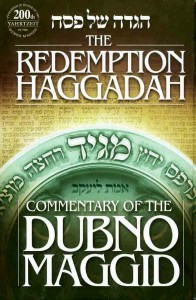 Both of these Hagaddot are wonderful resources for fans of parables (and who isn’t a fan of a good parable?). Nevertheless, they are somewhat impractical for the Seder. A parable often takes a long time to read, so by the time the reader finishes reading one, he may be several paragraphs behind the other Seder participants. By the time he finishes relating the parable (and its message), his listeners may be getting antsy. Best to read the Haggadah before the Seder and try to compact the material efficiently. The following excerpts are the shortest pieces from The Palace Gates Haggadah. (An anthology, it contains more material than and somewhat overlaps The Redemption Haggadah.)
Both of these Hagaddot are wonderful resources for fans of parables (and who isn’t a fan of a good parable?). Nevertheless, they are somewhat impractical for the Seder. A parable often takes a long time to read, so by the time the reader finishes reading one, he may be several paragraphs behind the other Seder participants. By the time he finishes relating the parable (and its message), his listeners may be getting antsy. Best to read the Haggadah before the Seder and try to compact the material efficiently. The following excerpts are the shortest pieces from The Palace Gates Haggadah. (An anthology, it contains more material than and somewhat overlaps The Redemption Haggadah.)
“Afterwards they shall go forth with great possessions.”
Our Sages tell us that the “great possessions” promised to Avraham Avinu at the Covenant between the Portions was the Torah which his children received at the foot of Mt. Sinai. But if this is indeed true, why were we commanded, before leaving Egypt, to ask the Egyptians for money and goods?
The Maggid of Dubno answered with one of his most famous parables.
A wealthy merchant needed a young boy to deliver packages to his customers’ houses. It was vacation time, so he offered the job to his friend’s son with the promise that he would be handsomely paid with a purse full of silver coins. The boy felt fortunate for being given the opportunity, and he worked earnestly for the entire vacation. When the time came for him to take his leave, it occurred to the merchant that a purse full of silver coins was too small a payment for the splendid services the boy had rendered him. He therefore put the silver aside, and instead wrote out a check for an amount many times the total value of the silver. But the boy, instead of thanking his employer for his generosity, sullenly stuffed the piece of paper into his pocket and went home weeping.
The next day, his father called at the merchant’s house and said to the wealthy man: “You have been most generous to my son and I want to thank you. But the boy is still a child and does not understand the value of a check. All he knows is that he expected to receive a bag filled with shiny new coins, and that instead he got a plain sheet of paper. Therefore, I would be most grateful if you would let him have at least part of his wages in silver coins….”
“Joyful in Your sacrificial service.”
…This need to seek outside entertainment is a sign of inner emptiness. It is also the subject of a parable given by the Maggid of Dubno.
A father and son were traveling together, and stopped at an inn on the way. The innkeeper served them a heavily spiced meat dish. The father refused to eat it, but the smell of the spices wafted into his son’s nostrils and made his mouth water.
“Why don’t you eat, Abba?” the boy asked. “The smell of this food is irresistible!”
“That’s the problem, my son,” the father replied. “The meat is spoiled. It has already become putrid and begun to stink. The spices testify to this. If the meat was good, not nearly as much spice would be needed!”
The Heritage Haggadah
By Eliyahu Kitov
Translated from the Hebrew by Gershon Robinson
Feldheim Publishers
Jerusalem, 1999
413 pages
While The Heritage Haggadah contains an excellent commentary, it is even more valuable for its ninety-five pages of introductory material and its 107 pages of appendices. The introductory material on all aspects of the preparations for the Seder, other observances that precede the Seder and the structure of the Seder as well as the appendices “A Compendium of Midrashim” and “Those Who Would Devour Yaakov: Persecution and Blood Libels” are phenomenal contributions to the experience of Pesach.
Customs of the Rabbis
In many Jewish communities, it was customary for rabbis and other halachic authorities to delay the start of their own Seders until long after the rest of the townspeople had begun theirs. Compared to other nights of the year, many more questions of law are liable to arise on the Seder night, for the laws forbidding chametz are more stringent than the laws regarding other types of forbidden foods, and punishment for violations of these laws is more serious, too. Were the rabbis to have begun their own Seders along with everyone else, they would not have been able to issue halachic rulings. Once they had made Kiddush over wine, they would be prohibited from ruling, since anyone who drinks a revi’is (86 grams) of wine is considered not to be in complete control of his faculties.
It is told that two of Jerusalem’s great rabbis, Rabbi Shemuel Salant and the Saba Kadisha, Rabbi Shelomo Eliezer Alfandi, came up with a brilliant way of helping to deal with this problem. They would pray Ma’ariv at the earliest possible time, quickly begin and finish their Seders, and then would rest for half an hour, in order to free themselves of the influence of the wine they had drunk. Then they would make themselves available for questions from their congregants, though at that time, practically everyone in the town would just be starting to recite the Haggadah. Congregants who had questions earlier, while the two rabbis were rushing to complete their Seders, would take them to other rabbis who had delayed their Seders!
The Haggadah in Any Language
Since the Haggadah’s primary purpose is to teach the children about the Exodus, and to publicize the miracles and wonders to all those attending the Seder, the leader must explain the Haggadah’s different elements and supply additional explanations, in a way that is understandable to all those present. He must be especially careful to make sure that the children understand, as well as the Seder participants who are unfamiliar with the language and the expressions used by our Sages. Outside the Land of Israel, where Jews do not usually speak lashon haKodesh—Hebrew, the language of the Haggadah—one should recite the Haggadah in the language of that particular country, for that is the language which is familiar to everyone.
On this point, the Beis Yosef writes (Orach Chaim 473):
“It should be recited in a language that the women and children understand, or it should be explained to them. This was the practice of R’ Yitzchak of Londerres … who would recite the entire Haggadah in English so that the women and children would understand.
It is said of the Chasam Sofer that he would recite the entire Haggadah in both Hebrew and German.
The Historical Haggada
By Nachman Cohen
Torah Lishmah Institute
New York, 2002
147 pages
(also available in Hebrew)
Rabbi Dr. Nachman Cohen’s Haggadah is a treasure trove of interesting and engaging material, much of which takes a refreshing, novel approach to the Haggadah. Historical context and insights, along with comprehensive analyses (such as his tabular correspondence of the twenty-six lines of Hallel Hagadol to the twenty-six generations from Adam until the Exodus) make this a truly innovative work.
HaMakom
Referring to God as HaMakom (the place) began in Talmudic times. God is never referred to by this noun in the period of Tanakh. The Midrash explains that HaMakom infers that “God is the space (place) of the universe and the universe is not His space (place).” What exactly does this mean, and more importantly, what gave rise to the use of this connotation?
The answer can be elucidated with the aid of ancient Greek thought. Greek philosophers were enthralled with the problem of change. Simply stated: How is change possible? If an object, x, truly changes into another object, y, this would mean that when x changes into y, x is annihilated and y is created from nothing. The Greeks rejected the notion of creation ex nihilo [something from nothing].
Several attempts were made to solve this problem.… Paramenides … argued that change was but an illusion. Change was logically impossible. Hence, it does not occur. The world is really composed of an unchanging oneness.
Paramenides had a student named Zeno. To reinforce his master’s point, Zeno devised many paradoxes which showed that change was not possible.…
The Paradox of Space
To exist, an object must be confined within a physical area. The room I am sitting in is within my office. This is within my home, which is on my street in Yonkers, which is in New York State, which is in the United States of America, which is within North America, which is on Earth, which is in our solar system, which is in the Orion Arm of the Milky Way Galaxy, which is in the Virgo Supercluster, which is in the visible Universe. But within what is the Universe contained? Since we are faced with an infinite regress, that is, everything must be contained within something else, and since there cannot be a last item which can exist without being contained, this proves that space is but an illusion.
The Rabbinic Response
The Rabbis responded to this last paradox of Zeno. Their response consisted of calling God “HaMakom.” By this they meant that “the world is encapsulated within God and not that God is encapsulated with the world.” It was God who created space. Only physical entities require space [and time] for existence. God, the Creator of space [and time] does not.
This response was important. The fallacy of the Greeks was that everything had a physical component. The pre-Socratics did not accept the notion of a totally spiritual being. The use of the term “HaMakom” serves to emphasize that the Greek scope of the Universe was incomplete and insufficient.
Opening the door for Eliyahu
…In this regard, the following excerpt from Josephus (Antiquities, Book 18: Ch. 2) is of some interest:
As Coponius … was exercising his office of procurator, and governing Judea, the following accidents happened. As the Jews were celebrating the Feast of Unleavened Bread, which we call Passover, it was customary for the priests to open the Temple gates just after Midnight. When, therefore, those gates were first opened, some of the Samaritans came privately into Jerusalem, and threw about dead men’s bodies in the cloisters; on which account the Jews afterward excluded them from the Temple, which they had not used to do at such festivals, and on other accounts also they watched the Temple more carefully than they had formerly done.
While Josephus gives no reason for the Temple gates being opened at Midnight on Pesach, there is no apparent reason to doubt his account … it is interesting to consider that our custom of opening the door after the meal might be as ancient as the Temple.
Touched by the Seder: The Pesach Haggadah with soul-stirring stories and commentary
By Rabbi Yechiel Spero
Mesorah Publications
Brooklyn, 2006
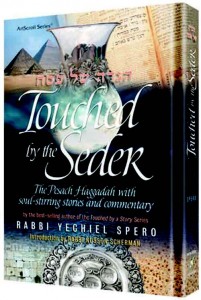 237 pages
237 pages
Touched by the Seder, part of Rabbi Yechiel Spero’s popular Touched by series, is not just a book of stories. It is a warm, homey and ultimately uplifting work. It too, like the From Bondage to Freedom Haggadah, is written in the first person, adding to its aura.
…The symbolism of the kittel, as perceived by the Tiferes Shlomo, Rav Shlomo of Radomsk, is perhaps the most striking, and powerful. Rav Shlomo, as he donned his kittel before the Seder would declare.… And then he would pause and begin to cry, “Heilige Bashefer, may all the neshamos that join us here tonight find the proper tikkun (rectification) for their needs.”
In other words, the Tiferes Shlomo implied that when one wears a kittel he is representing all the neshamos from generations past; all those who have gone to the next world now come to join us at the Seder. Zeides and bubbies, opas and omas, sabas and savtas, and grandpas and grandmas. Tonight, at the Seder, they come to shep nachas from their offspring.
The Haggadah states: “Bechol dor vador chayav adam liros es atzmo k’ilu hu yatza MiMitzrayim, In each and every generation one is obligated to view himself as if he went out of Mitzratim.” But there is another depth of meaning—“Bechol dor vador, together with each and every generation.” As we don our kittels, we sense that our ancestors have joined us to celebrate the past and, even more, to anticipate a glorious future.
The Wicked Son
…Let us examine the pesukim which introduce us to the rasha. In these pesukim we find the word Vehayah, which, the Gemara tells us, always signifies joy. Isn’t it odd that the word “joy” is associated with the rasha?
But there is reason to be joyous. Think about it—this rasha could have been anywhere tonight. But instead, as uncomfortable as it may be for him to sit among family members who do not think highly of him, he is at the Seder. And he cares enough, and is brave enough, to speak his mind in front of the group!…
…Let us take a look at the word rasha itself, at the letters that form the word, and another layer of meaning will be uncovered. The Belzer Rebbe revealed a penetrating insight. The letters reish and ayin, spelling ra, are found at the outside ends of the word rasha, but a shin is what fills the middle. On the outside he appears to be ra, but on the inside he is just a little boy crying for help. The shin has three crooked branches sprouting forth from the same root. Perhaps it is telling us that at the very core of this “rasha” is a confused child who is linked forever, eternally, to the root of Avraham, Yitzchak, and Yaakov, never to be detached. And that is another reason for simchah.
Haggadah Simchas Yavetz/English Commentary
Insights and comments on the Pesach Haggadah: Its text, form and structure
By Rabbi David Cohen
Translated by Rabbi Zev Meisels
Mesorah Publications
Brooklyn, 1993
281 pages
Rabbi David Cohen is one of the foremost posekim in the United States and, at the same time, a true scholar and an insightful person. Hence, his Haggadah (whose publication preceded all the others reviewed here) includes aspects that resemble Rabbi Wein’s Haggadah (the insights); The Rav Shlomo Zalman Haggadah (the halachot and minhagim; and The Historical Haggadah (the historical and contextual explanations).
We were slaves
It was because Egypt was so enmeshed in carnality that in Egypt the Jews were told (see Sotah 12a, Hoshivah B’Aperion) to marry their wives with chuppah. Chuppah, in which the bride and groom are sequestered in a private place, symbolizes the togetherness of the couple and their constancy, and thus separated the Jews from the Egyptians, who were renowned for their marital laxity.
(My friend, Gavriel Iseson, n”y, pointed out that historically the Egyptians were the first to use yeast to prepare bread. This fits with their history of immorality, for the yetzer hara, the evil inclination, is compared by Chazal to yeast in dough.)
Nishmas
The Machzor Vitri (Seder Leil Pesach L’Rashi, quoted in Siddur Otzar HaTefillos, Tikkun Tefillah) writes that some claim that Nishmas was written by Shimon Kipah or Keifa (whom the Christians know as the apostle Saint Peter); this is followed by the emphatic statement that it is not so, and that anyone who repeats the story will be obligated to bring a sin-offering when the Beis HaMikdash is rebuilt.
The Machzor Vitri is referring to the popular legend that Shimon [Peter] was actually a Tanna, who, in order to distance a nascent Christianity from Judaism, pretended to become a Christian, and instituted laws for Christians designed to accentuate the break from Judaism, so that no Jew would find any similarity between the two religions and be fooled by it (see Jellinek’s Beis HaMedrash, Volume VI). It is evident that the Machzor Vitri disbelieved the tale; however, R’ Yehudah HeChassid (Sefer Chassidim #91) refers to Shimon Keifa as a righteous tzaddik who had followers who were evil, indicating that R’ Yehudah held the story to have basis in fact. Some say that he was known not as Shimon Keifa, Simon the Rock, but Shimon Kipa, Simon of the Dome, because he confined himself to a dome (or basilica) to avoid desecrating Shabbos, and lived on bread and water.
From the Gemara (Pesachim 118a) we can deduce that Nishmas dates from the time of the Anshei Knesses HaGedolah, the members of the Great Assembly, for we find Nishmas mentioned as part of the Haggadah (according to R’ Yochanan), whose precise text was probably established by the Anshei Knesses HaGedolah….
… It is very odd that on weekdays we recite only the Yishtabach portion of Nishmas. The source for this division is unclear, for the Gemara mentions only Nishmas in its entirety.
Rabbi Bechhofer is a maggid shiur at Yeshiva University High School for Boys and at Ohr Somayach in Monsey. He is also an editor at Artscroll/Mesorah.
